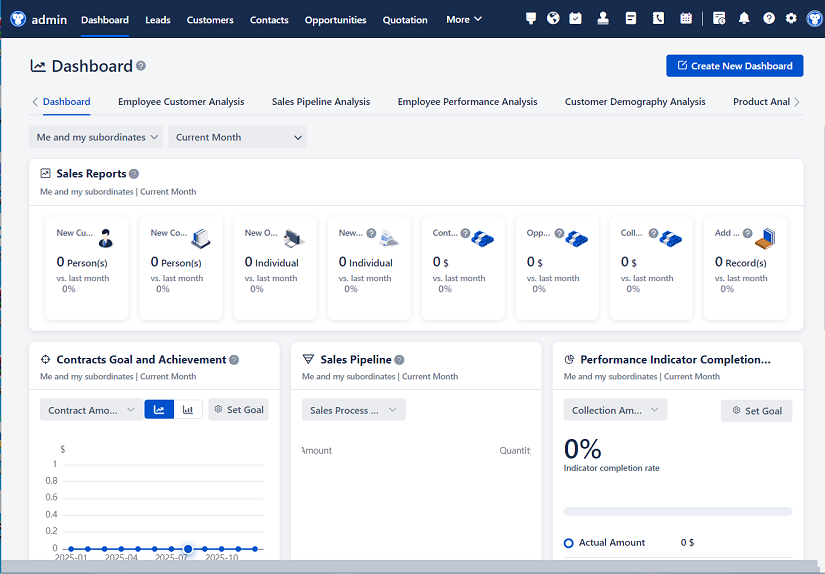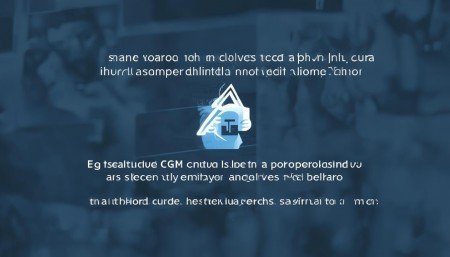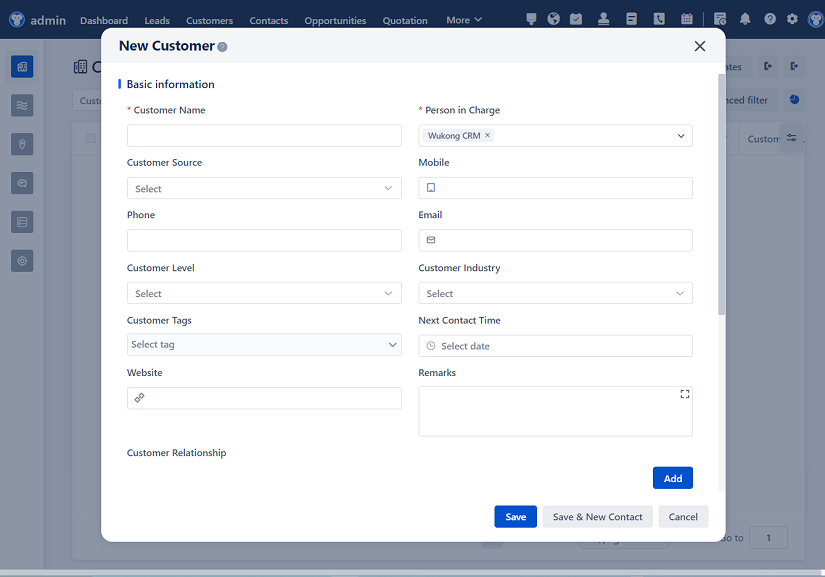
△Click on the top right corner to try Wukong CRM for free
Hey there! So, you're curious about the source code of CRM, or Customer Relationship Management systems, huh? Well, let's dive into it. Imagine for a second that you're running a business, and you want to keep track of all your customers, their preferences, and how they interact with your brand. That’s where a CRM system comes in. It’s like having a super-smart assistant who remembers everything about your clients and helps you build better relationships with them.

Now, when we talk about the source code of a CRM, we’re really getting into the nitty-gritty of how these systems are built. Think of it as the blueprint or the recipe that developers follow to create a CRM. The source code is the actual programming language that tells the computer what to do, how to store data, and how to present it to users. It’s kind of like the DNA of the software, if you will.
Let’s break it down a bit more. A CRM system typically has several key components. First up, there’s the database. This is where all the information about your customers, their interactions, and any other relevant data is stored. It’s like a giant digital filing cabinet, but way more organized and accessible. The source code here would include instructions on how to set up the database, what kind of data to store, and how to retrieve it efficiently.
Next, there’s the user interface (UI). This is what you and your team see when you log into the CRM. It’s the part that makes the system user-friendly and easy to navigate. The source code for the UI includes HTML, CSS, and JavaScript, which are used to create the layout, style, and interactive elements. It’s like decorating a room, but instead of furniture and paint, you’re using code to make it look and feel just right.
Then there’s the backend, which is the brain of the operation. This is where the heavy lifting happens—processing data, handling requests, and making sure everything runs smoothly. The source code for the backend might be written in languages like Java, Python, or C#. It’s like the engine under the hood of a car, quietly doing all the work to keep things moving.
But wait, there’s more! A good CRM also needs to integrate with other tools and services. Maybe you want to connect it to your email marketing platform, or maybe you need it to sync with your accounting software. The source code for these integrations is crucial because it allows the CRM to talk to other systems and share data seamlessly. It’s like setting up a network of friends who can all communicate and share information with each other.
Now, let’s talk about some of the challenges that come with writing the source code for a CRM. One of the biggest is making sure the system is scalable. As your business grows, you’ll have more customers, more data, and more complex interactions to manage. The source code needs to be flexible enough to handle this growth without slowing down or breaking. It’s like building a house that can expand as your family gets bigger, but still feels cozy and functional.

Another challenge is security. You’re dealing with sensitive customer data, so you need to make sure it’s protected from unauthorized access. The source code should include robust security measures, like encryption, authentication, and regular updates to patch any vulnerabilities. It’s like putting a lock on your front door, but also installing an alarm system, security cameras, and maybe even a guard dog, just to be extra safe.
And then there’s the issue of customization. Every business is different, and a one-size-fits-all approach doesn’t always work. The source code should be modular and customizable, allowing you to add or remove features as needed. It’s like having a wardrobe where you can mix and match different pieces to create the perfect outfit for any occasion.
So, how do developers actually write the source code for a CRM? Well, it starts with planning. They sit down and figure out what the CRM needs to do, what features it should have, and how it should work. Then they start coding, testing, and refining. It’s a bit like building a puzzle, where each piece of code fits together to create the final picture.
One of the most important aspects of writing CRM source code is documentation. Developers need to leave clear, detailed notes on how the code works, what each part does, and how to use it. This is especially important if multiple people are working on the project, or if someone else needs to maintain the code in the future. It’s like leaving a map and a set of instructions for anyone who might need to find their way around the system.
Speaking of maintenance, that’s another big part of the process. Once the CRM is up and running, it needs to be regularly updated and maintained. This means fixing bugs, adding new features, and keeping the system secure. It’s like taking care of a garden—watering it, pruning it, and making sure it stays healthy and vibrant.
Now, let’s talk about some of the popular CRM platforms out there and what their source code looks like. For example, Salesforce is one of the biggest names in the CRM world. Their source code is a mix of proprietary and open-source technologies, and they have a robust developer community that contributes to and extends the platform. It’s like a big, bustling city where everyone is working together to make it better.
On the other hand, there are open-source CRM solutions like SuiteCRM and Odoo. These platforms allow you to see and modify the source code yourself, which is great if you have specific needs or want to customize the system. It’s like having a DIY kit where you can build and tweak the CRM to your heart’s content.
But why would you want to look at the source code of a CRM in the first place? Well, there are a few reasons. If you’re a developer, understanding the source code can help you build custom integrations, fix issues, or add new features. It’s like being able to peek under the hood of a car and tinker with the engine. If you’re a business owner, knowing a bit about the source code can give you a better understanding of how the CRM works and what it’s capable of. It’s like learning a bit about cooking so you can appreciate a good meal even more.
Of course, not everyone needs to be a coding expert to use a CRM. Most modern CRMs are designed to be user-friendly, with intuitive interfaces and easy-to-use features. But having a basic understanding of the underlying technology can be really helpful, especially if you ever need to troubleshoot or make changes.

So, there you have it—a quick rundown of the source code of CRM systems. It’s a complex and fascinating topic, and I hope this gives you a good starting point. Whether you’re a developer, a business owner, or just someone curious about how these systems work, there’s always more to learn and explore.
Alright, now that we’ve covered a lot of ground, let’s wrap things up with a few questions and answers. Feel free to ask me anything else you’re curious about!

Q: What is the main purpose of a CRM system? A: The main purpose of a CRM system is to help businesses manage and analyze customer interactions and data throughout the customer lifecycle. It helps in improving customer relationships, increasing sales, and providing better customer service.

Q: Can I customize the source code of a CRM system? A: Yes, you can customize the source code of a CRM system, especially if you’re using an open-source solution. However, for proprietary systems like Salesforce, you may need to use their development tools and APIs to make customizations.

Q: What are some common programming languages used in CRM development? A: Common programming languages used in CRM development include Java, Python, C#, PHP, and JavaScript. The choice of language often depends on the specific requirements and the platform being used.
Q: How important is security in CRM source code? A: Security is extremely important in CRM source code because these systems handle sensitive customer data. Robust security measures, such as encryption, authentication, and regular updates, are essential to protect against data breaches and unauthorized access.

Q: What are the benefits of using an open-source CRM? A: Using an open-source CRM offers several benefits, including the ability to customize the source code, lower costs, and a strong community of developers who contribute to and support the platform. It’s a great option if you have specific needs or want full control over the system.
Q: How do I get started with developing a CRM system? A: To get started with developing a CRM system, you should first define your requirements and plan the features you need. Then, choose a suitable programming language and framework, and start coding. Don’t forget to test and iterate as you go along. There are also many resources and tutorials available online to help you get started.

I hope these Q&A’s help! If you have any more questions, feel free to ask. Happy coding!
Related links:
Free trial of CRM
Understand CRM system
AI CRM Systems

△Click on the top right corner to try Wukong CRM for free